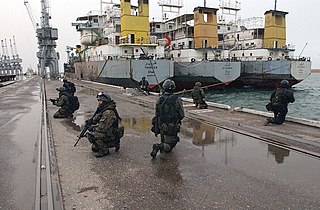
K-141 Kursk was an Oscar II-class nuclear-powered cruise-missile submarine of the Russian Navy.

The Hunt for Red October is the debut novel by Tom Clancy, first published on October 1, 1984 by the Naval Institute Press. It depicts Soviet submarine captain Marko Ramius as he seemingly goes rogue with his country's cutting-edge ballistic missile submarine Red October, and marks the first appearance of Clancy's most popular fictional character Jack Ryan, an analyst working for the Central Intelligence Agency, as he must prove his theory that Ramius had intended to defect to the United States. The book was loosely inspired by the mutiny on the Soviet frigate Storozhevoy in 1975.
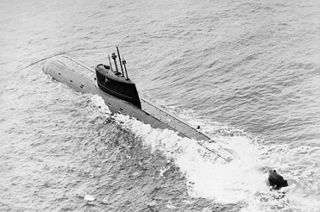
K-278 Komsomolets was the only Project 685 Plavnik nuclear-powered attack submarine of the Soviet Navy. On 4 August 1984 K-278 reached a record submergence depth of 1,020 metres in the Norwegian Sea. The boat sank in 1989 and is currently resting on the floor of the Barents Sea, one mile deep, with its nuclear reactor and two nuclear warheads still on board. The single Project 685 was developed to test technologies for Soviet 4th generation nuclear submarines. Although primarily intended as a developmental model, it was fully combat capable, but sank after a fire broke out in the aft engineering compartment on its first operational patrol.

U-505 is a German Type IXC U-boat built for Germany's Kriegsmarine during World War II. She was captured by the U.S. Navy on 4 June 1944.

HMS Invincible was the Royal Navy's lead ship of the three light aircraft carriers in her class. She was launched on 3 May 1977 as the seventh ship to carry the name. She saw action in the Falklands War when she was deployed with HMS Hermes and took over as flagship of the British fleet when Hermes was sold to India. Invincible was also deployed in the Yugoslav Wars and the Second Gulf War. In 2005, she was decommissioned and eventually sold for scrap to the Turkish company Leyal Ship Recycling in February 2011.

USS John A. Moore (FFG-19), eleventh ship of the Oliver Hazard Perry class of guided-missile frigates, was named for Commander John Anderson Moore (1910–1944). Ordered from Todd Pacific Shipyards, Los Angeles Division, San Pedro, California on 28 February 1977 as part of the FY77 program, John A. Moore was laid down on 19 September 1978, launched on 20 October 1979, and commissioned on 14 November 1981.
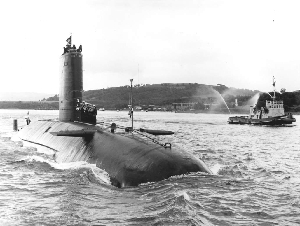
HMS Conqueror was a British Churchill-class nuclear-powered fleet submarine which served in the Royal Navy from 1971 to 1990. She was the third submarine of her class, following the earlier Churchill and Courageous, that were all designed to face the Soviet threat at sea. She was built by Cammell Laird at Birkenhead.

USS Nautilus (SSN-571) was the world's first operational nuclear-powered submarine and the first submarine to complete a submerged transit of the North Pole on 3 August 1958.

USS Triton (SSRN/SSN-586) was a United States Navy radar picket nuclear submarine. In early 1960 it became the first vessel to execute a submerged circumnavigation of the Earth. Triton accomplished this objective during her shakedown cruise while under the command of Captain Edward L. "Ned" Beach, Jr. The only member of her class, she also had the distinction of being the only Western submarine powered by two nuclear reactors.

USS Grayback (SS-208), a Tambor-class submarine, was the first ship of the United States Navy to be named for the lake herring.

The Spy Who Loved Me is a 1977 British spy film, the tenth in the James Bond series produced by Eon Productions, and the third to star Roger Moore as the fictional secret agent James Bond. Barbara Bach and Curt Jürgens co-star. It was directed by Lewis Gilbert and the screenplay was written by Christopher Wood and Richard Maibaum.
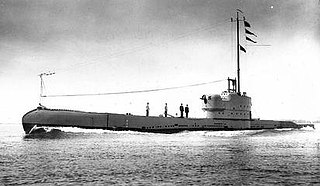
HMS Parthian was the lead boat of the six Royal Navy Parthian-class submarines, all launched in 1929. The submarine was sunk in 1943 during the Second World War. The submarine was nicknamed Peanut, from the identity letters PN painted on the fin.
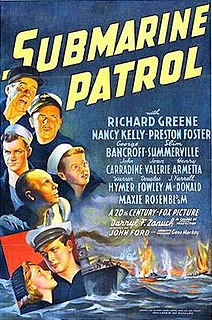
Submarine Patrol is a 1938 film directed by John Ford and starring Richard Greene and Nancy Kelly. The supporting cast includes Preston Foster and George Bancroft. The movie was partly written by William Faulkner.

Juan Guillermo Moore Ruiz,, was a British Peruvian navy officer. He was killed during the Battle of Arica.
SAS Spear, initially known as the SAS Maria van Riebeeck, was a Daphné-class submarine of the South African Navy (SAN). Built in France during the 1960s, the boat was the SAN's first submarine. It was scrapped in June–July 2003.

Rear-Admiral, Submarines is a post in the Royal Navy which involves command of the Royal Navy Submarine Service. It evolved from the post of Inspecting Captain of Submarines in 1901 and would later evolve to become the post of Flag Officer Submarines in 1944.

Italian submarine Enrico Toti was the first of a new class of Italian submarine (Toti-class), with the S 506 Enrico Toti being laid down in 1965, launched in 1967, decommissioned in 1992 and preserved as a museum ship in Museo della Scienza e della Tecnologia "Leonardo da Vinci", in Milan. The ship, and class, are named after the Italian Enrico Toti.

The Anti-Submarine Division its original name, was the former anti-submarine warfare, planning and prevention Directorate of the Admiralty Department from 1912-1963.

The Naval Assistant to the First Sea Lord also known as the Executive Assistant to the First Sea Lord was a senior appointment of the British Royal Navy established in 1905 until 2014. The post holder was responsible for assisting the First Sea Lord in the discharging of his duties and responsible for administrative and secretarial work within the private office of the First Sea Lord.
